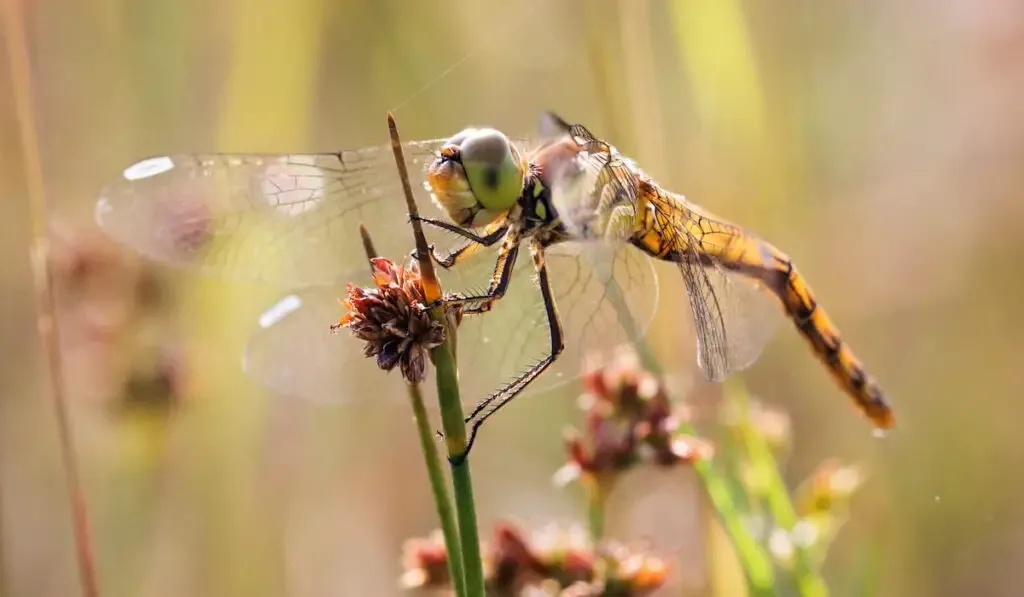Dragonflies are elegant and refined insects. People who love nature are likely to get enchanted by its beauty and charm.
They are delightful insects with intricate wings which bewitch anyone who notices them. No wonder poets have been investing time in describing the beauty of dragonflies in their poetry. Nobody can deny the charm of their enchanting bright wings.
Dragonflies and Damselflies belong to the same family of insects called Odonata that tend to spend their early life in water and later part of life in the air or land. In ancient times, they were equal to the size of a bird, but they changed over time.
Odonates undergo beautiful morphological changes, which are be considered a beautiful marvel of nature. Newly adult odonates are called tenerals. They are very fragile during that stage, which lasts only for one day. In that stage, tenerals appear light hues on its wings which become darker after they are fully grown.
Their suborders are different which makes them differ from each other in many aspects. However, there are also many similarities that could be noted in them. Some of which are as follows:

Table of Contents
Similarities between Dragonflies and Damselflies
Damselflies and dragonflies are related to each other because they belong to the same order, so there are many features that you will find similar in them.
- Both insects have big bodies and bulky eyes as compared to their body.
- People tend to wonder if the dragonflies or damselflies bite or sting. The answer is that they do not sting. They might bite you instead because they have teeth to catch their prey. However, their bite is not harmful to human beings.
- Both members of the Odonata family tend to prey on other animals. For instance, flies, bees, tadpoles, insects, and many other tiny animals.
- Both of them breathe air with the help of their skin. They must have damp skin to do so.
- They are mostly inhabitants of ponds, oceans, lakes, or still waters.
- They are environment-friendly insects because they eat harmful insects and don’t let them increase in number.
- Their wings are the same in transparency and prominent veins.
- Both of them breed in an aquatic environment.
- They catch their prey in the blink of an eye. After hunting the prey, they come back to their comfortable position to devour their meal. Male insects are known to move in swarms to hunt.
- They cannot fly in harsh weather, so they prefer to stay in vegetation to keep themselves safe.
- They can be used as barometers to know the water quality. They cannot reach adulthood in bad-quality water.
- As they survive only in the clean aquatic environment so, they are also useful to indicate climate change. Their presence in the environment is proof of pollution-free and harmless surroundings. Their absence in the air could directly influence human beings and other creatures. Their large variety helps in keeping the surroundings free from harmful insects like mosquitoes. Hikers appreciate the presence of these winged insects because they eat mosquitoes.
- Changing water levels, extra-human activities around water, extreme change in climate, overshading by trees, and extra nutrients in the water are great threats to their lives.
- Like other insects, odonates do not pass through the pupal stage. When the larva starts maturing, it comes out of the water on a plane surface where the immature skin ruptures and the insect comes out.
- Dragonflies or damselflies could be of different shades. For instance, black, brown, yellow, and red. Their internal structure allows them to appear blue on their skin. Yellow and green hues might fuse to give the green color. Their eyes are of metallic color. They can make their colors prominent with time as they grow.
- Various kinds of animals eat dragonflies and damselflies. Birds such as kingfishers, kingbirds, and small hawks devour on both adult/larvae damselflies and dragonflies. Frogs hunt them with their adhesive tongues. Any type of fish could come out of the water to get dragonflies or damselflies if they are flying on top of the water. Their sharp sightedness often saves them from being hunted or eaten.
Differences between Dragonflies and Damselflies
You can differentiate dragonflies and damselflies by noting the following features:
| Dragonflies | Damselflies |
| The body of dragonflies is sturdier and stronger with segments. | Damselflies, leaving out spreadwings and Aurora Damsel, have fragile and flimsy bodies. |
| They keep their wings outstretched or expanded when they perch to rest, apart from Swift Setwing and Blue Dasher which spread their wings in the forward position. | They tend to wrap their wings around their abdomen to rest. |
| Dragonflies are adroit fliers. They get admiration for the maneuvers they perform in the air. One could call them the lord of air because very few insects could fly the way they do. You can easily catch them when they are accessible. Otherwise, they fly with such speed that sometimes it’s hard to catch them insight. | Damselflies cannot fly as adroitly as dragonflies. They keep their flight low to the ground. However, they might perch high when they are in shady places. |
| Dragonflies tend to capture their prey when they are maneuvering in the air. They can hunt even when they are flying at a higher speed. Unlike damselflies, they prefer to catch their prey at a warm temperature. | As Damselflies keep their flight low, so they tend to hunt in cold temperatures near vegetation. |
| Female dragonflies are more likely to meet their partners in the air. You can generally see the couples wooing while they are flying. | They tend to meet their partners secretly. You don’t see them wandering about together. |
| Gills are built internally, and they could stretch or shrink their abdomen to bring water in their gills. | The gills are in an outward direction and stick out of larvae. |
| Despite being predators, dragonflies are more prone to get attacked by outsiders, For instance, birds. They also get stuck in spider webs and sharp spines of other plants. | Less likely to be invaded by predators. |
| Must keep their body hot to fly in a proper way so they quiver their thorax muscles to make their body warmer and shiny. | They tend to spread their wings instead of vibrating them, to let the sunshine absorb in their wings that way they are able to fly. |
| Dragonflies are a bit bulky and have a long body. | They are smaller in size as compared to dragonflies. |
| Dragonflies have bulky eyes and generally, there is no space between their eyes. | Damselflies’ eyes are also big but not as big as dragonflies. Their eyes are perched separately on their head. |
| Dragonflies mostly have unmatched wings. The rear wing of them is wider than the forewings. | Damselflies’ rear wings and front wings are equal in size and shape. |
| Dragonflies breed in water and when they hatch eggs, larvae do not leave the water until it is fully grown. | Damselflies also lay eggs in water; however, they hatch them in vegetation. |
| The morphology of their eggs also differs even before they are hatched. Dragonflies belong to the suborder called Antisaptora. | Damselflies are a part of the Zygoptera suborder. |
| As dragonflies prefer to live in water, however, when they need to get oxygen, they uncover just the tip of their stomach to absorb oxygen. | Damselflies, on the other hand, come to the surface and expose their full body to get oxygen from the outside environment. |
| Dragonflies tend to creep in vegetation. | They are seen to climb on plants or vegetation. |
| Dragonflies cannot bear pollution. | They can undergo pollution. |
| Dragonflies could scatter to distant places to hunt. | Damselflies prefer to stay near their habitat. |
| Grown dragonflies have a lifespan of six weeks | A fully grown damselfly lives for 3-4 weeks. |
How to Attract Dragonflies and Damselflies

While there are several recommendations for constructing a place that can attract butterflies, there are also few to attract and encourage dragonflies.
Houses with water gardens, lakes, and freshwater can enhance quality habitat for dragonflies and damselflies and by:
- Decreasing the application of toxicants and fertilizers which can add in the water extinguishes the odonates and destroy the sources on which they survive.
- Make sure to give aeration in water sources to enhance oxygen for the larval odonates – some persist only if the water is bubbling like in rivers and rills.
- Resist the inclination to eliminate remains from underwater, as it gives habitat for both Odonata and prey.
- Grow water plants and maintain sticks and rocks on the brink of water to help insects come out of water.
- If you want to experience the charm and beauty of dragonflies or damselflies, visit aquatic places in spacious parks or the edge of a lake, ocean, etc. Some of these insects prefer to live on permanent freshwaters while some may survive near pools. There you could find a variety of these insects flying and maneuvering everywhere. Some of their families are active during dusk while some prefer to move around at dawn.
References:
- https://ucmp.berkeley.edu/arthropoda/uniramia/odonatoida.html
- https://ovlc.org/dragonflies-and-damselflies/
- https://www.treehugger.com/how-tell-difference-between-dragonfly-and-damselfly-4864536
- https://www.bnl.gov/esd/wildlife/files/research/pdf/dyer_2003_paper.pdf
- https://cals.arizona.edu/yavapai/anr/hort/byg/archive/dragonfliesanddamselflies.html
